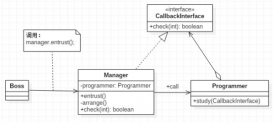什么是 mybatis ?
mybatis 是一款优秀的持久层框架,它支持定制化 sql、存储过程以及高级映射。mybatis 避免了几乎所有的 jdbc 代码和手动设置参数以及获取结果集。mybatis 可以使用简单的 xml 或注解来配置和映射原生信息,将接口和 java 的 pojos(plain old java objects,普通的 java对象)映射成数据库中的记录。
1、foreach 循环
foreach 元素的属性主要有 item, idnex, collection, open, separator, close。
1.collection:传入的 list 或 array 或自己封装的 map。
2.item:集合中元素迭代时的别名。
3.idnex:集合中元素迭代是的索引。
4.open:where 后面表示以什么开始,如以‘('开始。
5.separator:表示在每次进行迭代是的分隔符。
6.close:where后面表示以什么结束,如以‘)'结束。
|
1
2
3
4
5
6
7
8
9
10
|
//mapper中需要传递一个容器public list<user> querybyidlist(list<integer> useridlist);<select id="querybyidlist" resultmap="baseresultmap" parametertype="map"> select * from user where userid in <foreach collection="useridlist" item="id" index="index" open="(" close=")" separator=","> #{id} </foreach></select> |
2、concat 模糊查询
|
1
2
3
4
5
6
7
8
9
|
//模糊查询使用concat拼接sql<select id="querybyname" resultmap="baseresultmap" paramtertype"string"> select * from user <where> <if test="name != null"> name like concat('%', concat(#{name}, '%')) </if> </where></select> |
3、if + where 标签
用 if 标签判断参数是否有效来进行条件查询。
|
1
2
3
4
5
6
7
8
9
10
11
12
13
14
|
<select id="getuserlist" resultmap="baseresultmap" paramtertype="com.demo.user"> select * from user <where> <if test="userid !=null and userid!= ''"> userid= #{userid} </if> <if test="name !=null and name!= ''"> and name= #{name} </if> <if phone="userid !=null and phone!= ''"> and phone= #{phone} </if> </where></select> |
where 动态语句中,where 标签会自动去掉 and 或 or。防止 where and 错误。
4、if + set
使用 set 标签可以动态的配置 set 关键字,使用 if + set 标签,如果某项为 null 则不进行更新。
<update id="updateuser" paramtertype="com.demo.user">
update user
<set>
<if test=" name != null and name != ''">
name = #{name},
</if>
<if test=" phone != null and phone != ''">
phone = #{phone},
</if>
</set>
where userid = #{userid}
</update>
5、if + trim 代替 where/set 标签
trim 可以更灵活的去处多余关键字的标签,可以实现 where 和 set 的效果。
|
1
2
3
4
5
6
7
8
9
10
11
12
13
14
15
16
17
18
19
20
21
22
23
24
25
26
27
|
<select id="getuserlist" resultmap="baseresultmap" paramtertype="com.demo.user"> select * from user <trim prefix="where" prefixoverrides="and|or"> <if test="userid !=null and userid!= ''"> userid= #{userid} </if> <if test="name !=null and name!= ''"> and name= #{name} </if> <if phone="userid !=null and phone!= ''"> and phone= #{phone} </if> </trim></select><update id="updateuser" paramtertype="com.demo.user"> update user <trim prefix="set" suffixoverrides=","> <if test=" name != null and name != ''"> name = #{name}, </if> <if test=" phone != null and phone != ''"> phone = #{phone}, </if> </trim> where userid = #{userid}</update> |
5、choose(when, otherwise)标签
choose 标签是按顺序判断其内部 when 标签中的 test 条件是否成立,如果有一个成立,则 choose 结束。当 choose 中所有 when 的条件都不满足,则执行 otherwise 中的 sql。类似 java 中的 switch 语句,choose 为 switch,when 为 case,otherwise 则为 default。
|
1
2
3
4
5
6
7
8
9
10
11
12
13
14
15
16
17
|
<select id="selectcustomerbycustnameandtype" parametertype="map" resultmap="baseresultmap"> select * from user <choose> <when test="utype == 'name'"> where name = #{name} </when> <when test="utype == 'phone'"> where phone= #{phone} </when> <when test="utype == 'email'"> where email= #{email} </when> <otherwise> where name = #{name} </otherwise> </choose></select> |
总结
以上所述是小编给大家介绍的mybatis 常用写法 ,希望对大家有所帮助,如果大家有任何疑问请给我留言,小编会及时回复大家的。在此也非常感谢大家对服务器之家网站的支持!
原文链接:https://www.cnblogs.com/zt19994/archive/2018/11/22/9999696.html













